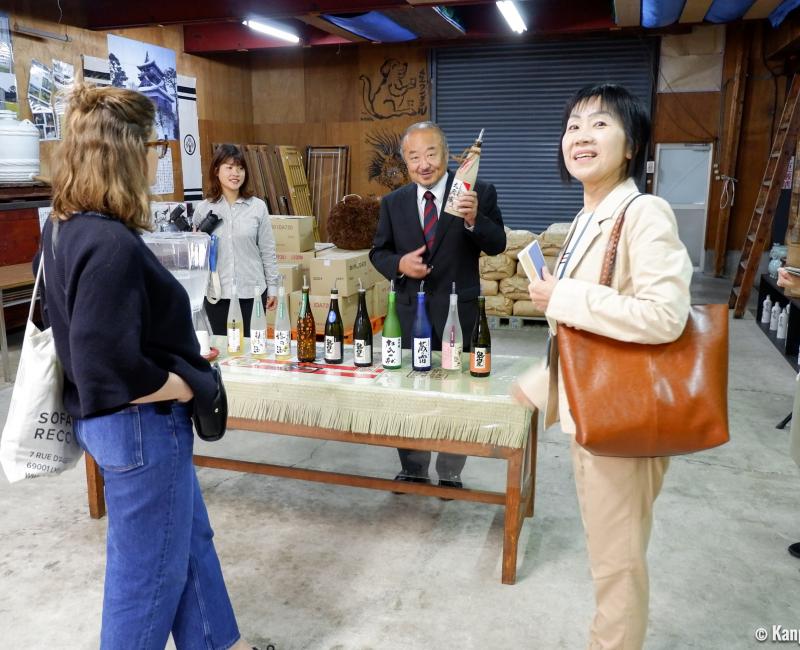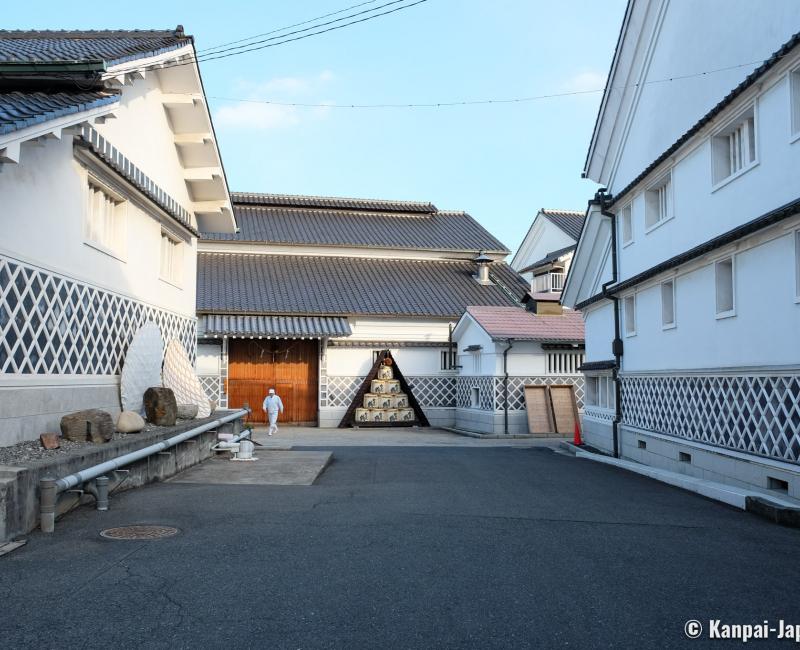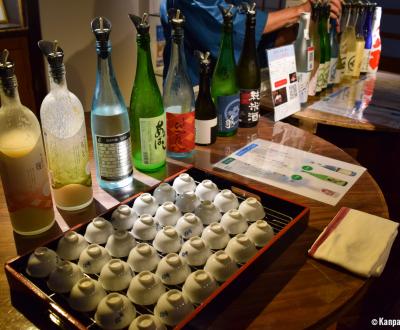Japanese Sake or Nihonshu
🍶 The Iconic Rice Alcohol of Japan
Japanese sake or nihonshu is an alcoholic drink made from fermented rice and originating from Japan. As typical as wine for France, sake is an integral part of the archipelago’s gastronomical culture and has many local variations. Nihonshu’s fruity, full-bodied or subtle flavors, as an appetizer or in association to a dish, delight a growing number of amateurs throughout the world.
In Japan, the word sake 🍶 (酒), or in its polite form osake (お酒), means alcohol generally speaking. When talking about Japanese sake, we are in fact referring to nihonshu (日本酒), or more rarely washu (和酒), that translates as "Japanese alcohol". It is therefore best to use the word "nihonshu" when ordering sake in Japan to avoid any confusion.

What is Japanese sake?
This typically Japanese alcohol, nihonshu, is made from rice fermented with koji, subsequently diluted with water. The brewing process was developed over the centuries and is to be found in every region of the archipelago, with unique terroir characteristics in each prefecture. The terme "Japanese sake" thus defines an infinite number of local sake, each with its own character and unique taste. Seasoned amateurs choose the best sake according to the quality of beverage, the rice polishing rate, but also regarding the brewery and the location where sake was produced.
Undiluted sake has an alcohol content of about 20% ABV. The final drink’s alcohol content is usually included between 13° and 17° and can be consumed cold or hot, at temperatures ranging from 5°C to 55°C, offering a large array of aroma and flavors in the mouth.
Thanks to its limpidity, nihonshu is classified as a clear alcohol, meaning that very few impurities due to the alcoholic fermentation remain. Therefore it would be more easily assimilated by the body and thus less prone to cause headaches on the day following a heavy drinking.
Excessive drinking put your health at risk. Alcoholic beverages should be consumed in moderation.
Lastly, do not confuse Japanese sake with other Asian alcohols, for example those served in small glasses with erotic images at their bottom. They are wrongly called sake and are generally distilled alcohols made from other cereals than rice, and their alcohol content is usually higher.
Ancestral and sacred origins
The origins of rice cultivation in Japan date back to the early Yayoi period (600 BC – 250 AC), first introduced by the Chinese in the north of Kyushu Island, before spreading to the rest of the archipelago. The making of sake was afterward closely linked to the mastering of rice paddies irrigation.
Nicknamed "the beverage of the gods," nihonshu has a prominent role within the Shinto rituals and is an offering to appease kami deities. When visiting a shrine in Japan, it is not uncommon to pass by rows of sake wood barrels named komodaru, or to see sake cups placed on the altar for praying.

A complex production process
The making of Japanese sake follows the passing of the seasons, and lasts about one year. The production cycle starts in October, whose first day is celebrated as the day of the sake Nihonshu no Hi (日本酒の日). Each brewery hangs at its front door a sakabayashi (酒林), a sphere of sugi cedar leaves that are let to dry, whose changing of colors from green to brown acts as a timeline to know the status of sake making.
1️⃣ Selection of the ingredients
Two ingredients are essential to nihonshu, which is made of 20% of rice and 80% of water. Water is therefore a key ingredient, and its choice has an impact on the type of sake produced. A water with high mineral content will make the drink dryer, whereas a water with low mineral contents will impart a softer taste to the sake.
As for the rice, the variety used is different from the rice for food. A specific variety named shuzo koutekimai (酒造好適米) is indeed used to make sake, mainly characterized by bigger rice grains, thus containing more starch. Its production only amounts to 5 % of the national rice crops, the other 95 % being hanmai (飯米), edible rice.
The shuzo koutekimai rice is more vulnerable to winds and typhoons 🌀, and thus less profitable. Only a small portion of the harvest reach the quality necessary to make exceptional sake, and the best breweries of the country are contending for it every year. Some breweries grow their own rice, but it is rare.
2️⃣ Rice polishing and washing
Rice harvesting ends in autumn 🍁, while nihonshu production begins: the first step is to remove the bran from each grain of rice. This polishing phase is named seimai (精米) in Japanese.
In addition to the outer brown layer, the upper layers of the grain, that are rich in amino acids, proteins and lipids, are removed, so as to keep only the core of the grain, where the highest starch content is. Brown rice grains are poured at the top of vertical mills, in which they are polished. At the end of polishing, they look like small white pearls.
The rice polishing rate indicates the percentage of the grain left and is used afterward in the appellation of the sake. Sake quality is higher when the polishing rate is higher as well, and is defined jointly with the quality of the other ingredients.
After polishing, the rice is washed with soft water to remove the last fine layer named nuka (ぬか) and soaked. The length of soaking is determined by the rice polishing percentage.
3️⃣ Rice cooking and koji making
The rice is steamed during a little bit less than one hour in large traditional bamboo baskets named koshiki (甑). Once cooked, the rice is still covered by a hard outer envelop, while its core has become tender.
Without waiting for it to cool down, the rice is placed in a hot and humid room named koji-muro (麹室), spread on wide boards named toko, then sprinkled with koji-kin (麹菌). This microscopic fungus is a mold that looks like a green powder, and it converts the rice’s starch molecules into sugar thanks to its amylase enzymes, in a natural process called saccharification. During 36 to 48 hours, the rice is frequently mixed to evenly spread the fungi and help their action. The result is a first transformation of rice, a ferment named koji (麹), ready to become an alcohol.
4️⃣ Alcoholic fermentation and yeast action
Koji is then placed in small casks, to which spring 🌸 water and yeast are added. The first fermentation step shubo starts when yeast grows and transforms simple sugars into alcohol.
The mixture is left to settle during 10 to 14 days, then is transferred to larger casks to begin the main fermentation period, the moromi. During 3 to 5 weeks, freshly steamed rice and spring water are added at specific moments, in a process allowing a bigger sake production.
Saccharification and fermentation are happening simultaneously, with koji degrading rice starch in simple sugars, and yeast converting the sugars into alcohol.
5️⃣ Pressing, filtering and pasteurization of nihonshu
Pressing consist in separating rice lees kasu from the alcoholic beverage. Batches of fermented rice are placed in cotton bags hanged to let the liquid drain drop by drop.
After pressing, the liquid has to be filtered as it still contains impurities. It is during the filtration stage that the sake’s aromatic profile and final color will be determined. Each brewery has its own technique, the most widespread being the use of coal for filtering.
The liquid is then left again to settle for some time to help separate the last sediments, after which it is pasteurized at 60-65°C to stop the action of the few last remaining enzymes.
6️⃣ Aging, diluting and bottling
Japanese sake is put to age during 3 to 12 months, and then bottled. Bottling process involves a last dilution with spring water to adjust the flavor and lower the alcohol content within the 13° to 17° range.

Visit a sake brewery in Japan
There are more than 1,700 sake breweries in Japan, dispatched throughout the country, from the remote countryside location to specific districts close to the city centers such as Saijo in Hiroshima, Nada in Kobe or Fushimi in Kyoto.
Many of them are open to the visit and organize guided tours all year long, mostly in Japanese language (and sometimes in English). After a detailed visit of the brewing house and kura warehouses, the tour usually ends with a sake tasting and a stop at the brewery’s shop.
We have selected a short list of sake breweries offering free guided tours or for a minimal fee:
- Hachinohe Shuzo in Aomori prefecture, the productor of Mutsu Hassen and Mutsu Otokoyama sake,
- Urakasumi in Shiogama, in the north-east of Sendai, in Miyagi prefecture,
- Imayotsukasa in Niigata, one of the most renowned breweries of the country,
- Hakoneyama in Odawara’s northern suburb, in Kanagawa prefecture,
- Fukumitsuya next to Kenroku-en garden in Kanazawa,
- Kamoizumi in Hiroshima, a brewery in Saijo district,
- Shushinkan in Kobe, in Nada district.
For those who would like to bring back nihonshu as a souvenir from their travel in Japan, remember duty-free importations are limited (for example 1 liter per adult of 21 years and older in the U.S.) The rules may vary depending on your home country and it is best to check beforehand, to avoid the forsaking of some precious bottles at the airport.
---
Only a few months are necessary to obtain a ready-to-drink nihonshu, of which about forty days solely for the transformation and fermentation phases, followed by the longest phase, the aging. Sake fabrication process is thus a lot shorter than wine’s for example.
One must drink sake young, preferably a short time after production, and ideally within the year following its bottling. "Aged" Japanese sake that have undergone a 2 years or more aging, named koshu (古酒) do exist, but they are very rare and not easy to find even in Japan.

